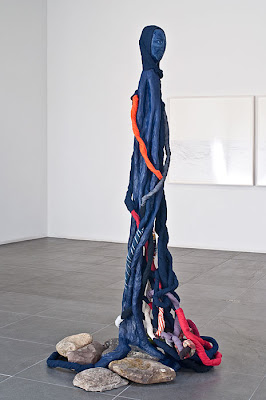 |
| Luisa Rabbia, Toward, 2012 (Wall installation)-230 portraits, dimensions variableFree-standing sculptures from left; Dual (2), Worlds, Oneself, various materials, all 2012 Image courtesy of Peter Blum, NY |
 |
| Luisa Rabbia, Oneself, 2012Free-standing sculpture, various materials Image courtesy of Peter Blum, NY |
Katy Diamond Hamer: Hi Luisa, it's great to see you and discuss your artwork, now on view at Peter Blum gallery titled Coming and Going. I'm interested in the idea of responding to humanity, nature and environment which is really evident as an exploration in your work and I'm wondering how much of this is based on your being based in New York.
Luisa Rabbia: Hi Katy, I'm glad we are able to have this conversation as well. As for my inspiration and being based in New York, I would say that the multicultural aspect of the city plays a large role in my process. In the last several years, I've started to realize the connectivity between human beings and nature, past, present and how everything is connected and overlaps throughout time. Especially in New York, there is an element of transience and even with several million people present, it is still possible to be aware of a sense of solitude that one can feel. I'm interested in an interconnection between my figures and the world but also am aware of the isolation that is relevant. Although I use what could be understood as roots or veins in my work binding humanity together, I'm also portraying a sense of solitude and independence. This concept for me represents the soul of New York as a city.
KDH: You are using fabric in your sculptural works, and I'm curious, is this something that you purchased, is it local to New York or relevant in representing a particular place or time?
LR: The fabric comes from friends. An interesting aspect that I experience when making or approaching a new body of work seems to be the phenomena that materials seem to arrive just when I need them, conceptually and literally. This was true also with the fabric that you see in these recent works. I often think of the quote from Johann Wolfgang von Goethe,
"Whatever you can do, Or dream you can, Begin it. Boldness has genius, power and magic in it. Begin it now."We can decide to choose a direction but we won't always end up arriving where we expected to be. It happens from the concept and action of starting something.
KDH: You mentioned thinking of some of your sculptures as drawing. This is something I can relate to as I often think of sculpture in relation to painting and the drawing process as well. How would you compare the different mental process you go through making a two-dimensional drawing versus a three-dimensional drawing?
LR: Even though the two works look different and may appear to have varied levels of control, there is more of playfulness than one might realize. However there are mistakes that happen when I am drawing and often, I just work around them following a very vague idea and allowing the dialogue with the material and the moment to take over. The most fascinating and interesting part of the process for me is to lose control when I am working and to see that from the original idea, I've arrived at a completely different place even though the original seed is still present. A big difference between the two processes is also the level of time needed to produce a finished piece. The more time I spend on a work the more I am aware of the evolution of the internal dialogue that I have with the work, I'd compare it to seeing a plant grow, it's organic.
KDH: Along with the organic quality of the artwork, there is also a specificity in the faces of the characters, delicately drawn. The figures seem like gypsies to me. They appear to be on a journey.
LR: You are the second person to say this! Actually when Peter Blum came to my studio, he spoke of the concept of an exodus, of movement and now you are also taking of the transient process and people moving.
KDH: There was an exhibition by artist Adel Abdessemed at David Zwirner and some of his works were also commenting on the nature of immigration, emigration and movement. I"m interested in an artists interpretation of time, the body, and how much information they are willing to translate between themselves, the work and the viewer.
LR: The way someone translates a piece of mine can also tell me something about his or her own experience. It opens new possibilities of ways that we can communicate. Every word and image we share may assist in finding and revealing various aspects of each of our personalities, histories and ways we can eventually connect. I love getting feedback from those who are looking at or experiencing my work
KDH: Agreed, the viewer will always bring different translations or projections as to what they are looking at. It's one of the powers of art and something that is expanding on a global level, merging an art historical past, the present and the always approaching future.
 |
| Luisa Rabbia, Traces (2), 2012 Silver point on prepared white paper 43 3/4 x 43 3/4 in(111 x 111 cm) each (Diptych) Image courtesy of Peter Blum, NY |
More soon!xo
Hiç yorum yok:
Yorum Gönder